The story of How Nicolet got started
The story of the Gamma Ray Spectrometer
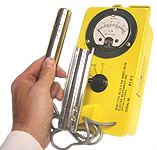 If you are old enough to remember
"Duck and Cover"
civil defense and the threat
of nuclear war you are likely to know what Geiger counters are. They click in response
to radioactivity. The clicks are slow and sporadic if there is only background
radiation, but the clicks become a roar in the presence of significant radioactivity.
Geiger counters are cheap and rugged and they respond to alpha and beta particles and
to gamma rays.
If you are old enough to remember
"Duck and Cover"
civil defense and the threat
of nuclear war you are likely to know what Geiger counters are. They click in response
to radioactivity. The clicks are slow and sporadic if there is only background
radiation, but the clicks become a roar in the presence of significant radioactivity.
Geiger counters are cheap and rugged and they respond to alpha and beta particles and
to gamma rays.
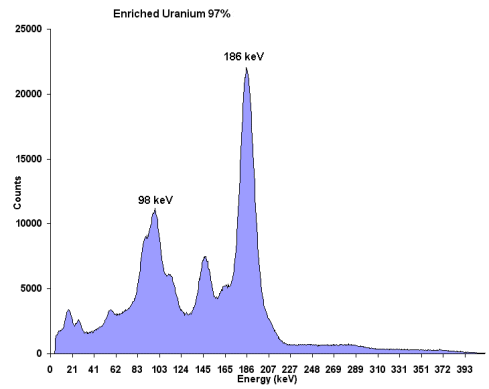 All radioactive isotopes produce characteristic gamma ray spectra. This makes it
possible to identify the source of the radiation which can be very critical information.
Here is an example of a gamma ray energy spectrum. It came from nuclear weapon grade
enriched uranium. A Geiger counter could detect the gamma rays from the uranium, but it
would not identify the source. The Geiger counter would just click.
All radioactive isotopes produce characteristic gamma ray spectra. This makes it
possible to identify the source of the radiation which can be very critical information.
Here is an example of a gamma ray energy spectrum. It came from nuclear weapon grade
enriched uranium. A Geiger counter could detect the gamma rays from the uranium, but it
would not identify the source. The Geiger counter would just click.
Scintillation Counters
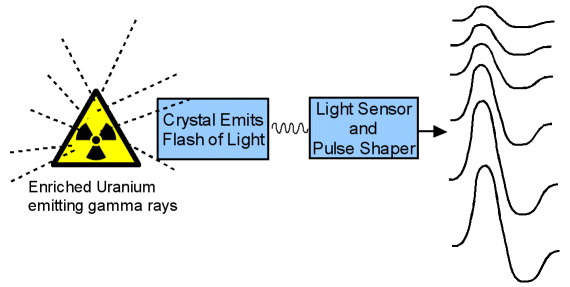 Fortunately, there is another way to detect gamma rays—the
scintillator. In this illustration, the crystal emits light flashes (it scintillates)
when it is struck by gamma rays. The key point is this: The intensity of the light flash
is proportional to the energy of the gamma ray. That makes it possible to construct a
gamma ray energy spectrum.
Fortunately, there is another way to detect gamma rays—the
scintillator. In this illustration, the crystal emits light flashes (it scintillates)
when it is struck by gamma rays. The key point is this: The intensity of the light flash
is proportional to the energy of the gamma ray. That makes it possible to construct a
gamma ray energy spectrum.
The old way to make a gamma ray spectrometer
 A gamma ray spectrometer looked like this in 1948: It was called a single
channel pulse height analyzer or a kick sorter. It was simple, but it could only measure
one energy at a time. "V" had to be adjusted before each data point. It took hundreds of
separate measurements to collect data to plot one spectrum with pencil and paper. It was
possible to "stack" single channel devices to gain speed. This becomes impractical if
more than few dozen are stacked.
A gamma ray spectrometer looked like this in 1948: It was called a single
channel pulse height analyzer or a kick sorter. It was simple, but it could only measure
one energy at a time. "V" had to be adjusted before each data point. It took hundreds of
separate measurements to collect data to plot one spectrum with pencil and paper. It was
possible to "stack" single channel devices to gain speed. This becomes impractical if
more than few dozen are stacked.
The new way to make a gamma ray spectrometer.
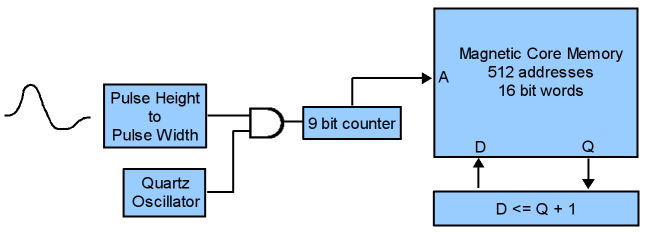 A gamma ray spectrometer looked like this in 1950: It was a vast
improvement and a good example of the application of the new digital techniques. It was
designed by Robert Schumann while working at Argonne National Laboratory. It was called
a multichannel analyzer (MCA.) It is essentially a 512 channel version of the above
single channel analyzer. This is the way it works: A pulse is generated with a width
proportional to the energy of the gamma ray. The same pulse is used to gate a precision
clock. The gated clock pulses are counted. The count is used to form an address for the
magnetic core memory. A one is added to memory at that address. This process is
sometimes called "kicksorting." After a few thousand gamma rays are sorted, a gamma ray
energy spectrum is created in memory, ready to be plotted.
A gamma ray spectrometer looked like this in 1950: It was a vast
improvement and a good example of the application of the new digital techniques. It was
designed by Robert Schumann while working at Argonne National Laboratory. It was called
a multichannel analyzer (MCA.) It is essentially a 512 channel version of the above
single channel analyzer. This is the way it works: A pulse is generated with a width
proportional to the energy of the gamma ray. The same pulse is used to gate a precision
clock. The gated clock pulses are counted. The count is used to form an address for the
magnetic core memory. A one is added to memory at that address. This process is
sometimes called "kicksorting." After a few thousand gamma rays are sorted, a gamma ray
energy spectrum is created in memory, ready to be plotted.
Nuclear Data, Incorporated
Robert Schumann knew the digital MCA was a very good idea. So he quit his job at Argonne and started a company called Nuclear Data, Inc. in Madison, Wisconsin, his home town. In 1958, Nuclear Data's capitalization was $8,000. In 1964, after tax profits were $400,000. It was a good idea and this is what it looked like.
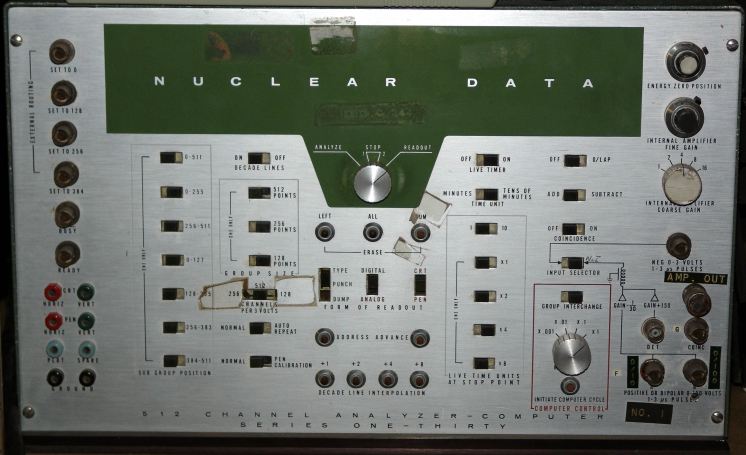
Nicolet Instrument Corporation
 In 1965, the board of directors decided that Nuclear Data would move to Chicago. Bob
Schumann wished to remain in Madison, so he cashed out. He ended up with $4,000,000
which he used to start a new company. He bought 40 acres of land South and West of
Madison where he had this 15,000 square foot building constructed. He also bought a nice
house and a nice boat. Four million dollars went further in those days. The new company
was called Fabritek Instruments because Fabritek put up some of the money. Fabritek was
a Minneapolis based manufacturer of magnetic core memory. It was certainly good
synergism. Donald Haselhorst was chosen by Fabritek to be the CEO. Fabritek's first
product, the 1050, very much resembled the Mnemotron. TMC had conveniently disappeared,
thus creating a niche. The 1050 was replaced by the 1060. Both machines used a type of
integrated circuit known as resistor transistor logic (RTL). Transistor transistor logic
(TTL) obsoleted RTL in 1969. This forced a quick redesign of the 1060. The result was
the 1070. The 1070 was still primarily a signal averager but it was possible to design
plugins for other application including pulse height analysis. The 1070 was very
successful. It was a cash cow for many years.
In 1965, the board of directors decided that Nuclear Data would move to Chicago. Bob
Schumann wished to remain in Madison, so he cashed out. He ended up with $4,000,000
which he used to start a new company. He bought 40 acres of land South and West of
Madison where he had this 15,000 square foot building constructed. He also bought a nice
house and a nice boat. Four million dollars went further in those days. The new company
was called Fabritek Instruments because Fabritek put up some of the money. Fabritek was
a Minneapolis based manufacturer of magnetic core memory. It was certainly good
synergism. Donald Haselhorst was chosen by Fabritek to be the CEO. Fabritek's first
product, the 1050, very much resembled the Mnemotron. TMC had conveniently disappeared,
thus creating a niche. The 1050 was replaced by the 1060. Both machines used a type of
integrated circuit known as resistor transistor logic (RTL). Transistor transistor logic
(TTL) obsoleted RTL in 1969. This forced a quick redesign of the 1060. The result was
the 1070. The 1070 was still primarily a signal averager but it was possible to design
plugins for other application including pulse height analysis. The 1070 was very
successful. It was a cash cow for many years.
Fabritek became Nicolet when it went public in 1971.
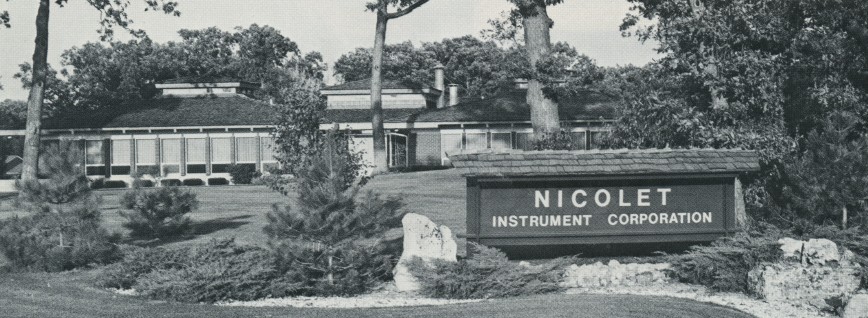
This was rural Wisconsin when it was built in 1965. Now, it is surrounded by strip malls, gas stations and a cineplex. But it still looks like this—an oasis surrounded by ugliness. It is still an attractive building and it was a pleasant place to work.